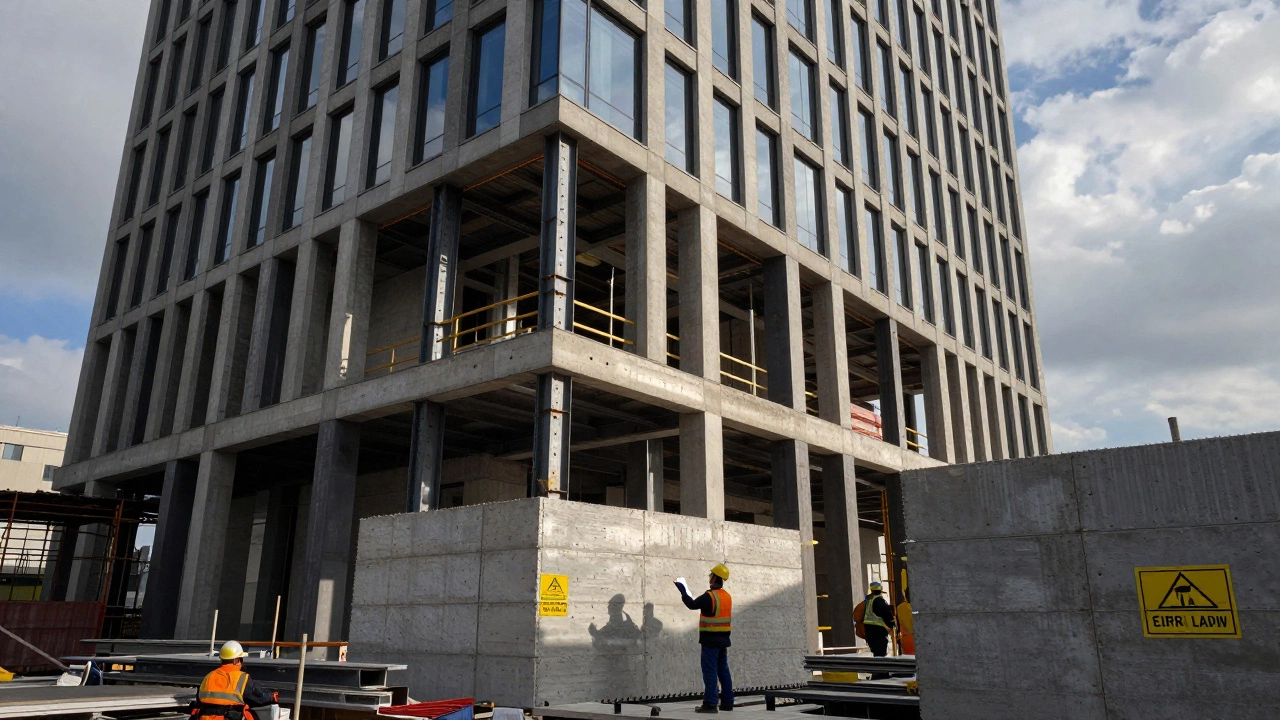Sticker shock hits hard when you see the quote for a loft conversion. It’s not just about throwing in some plywood and calling it a day. If you’re wondering which part of the process will burn through most of your cash, you’re not alone. Plenty of people, including my own neighbor (who’s still moaning about the dust), have been floored by the costs.
The truth? The structural work—things like steel beams, structural reinforcements, and changing the actual skeleton of your loft—usually eats up the biggest slice of your budget. Forget flashy windows and posh flooring for a second. Before you can even think about the fun details, you’ve got to make sure the whole structure can safely handle what you want to build up there. Skip this step, and you’re only waiting for a disaster (or a visit from a very stressed-out building inspector).
- Why Loft Conversions Are Pricey
- Where the Money Goes: Big Ticket Items
- Steelwork and Structural Changes
- Windows, Stairs, and Bringing in the Light
- Labour vs. Materials: What Costs More?
- Tips to Keep Your Loft Conversion Budget Under Control
Why Loft Conversions Are Pricey
Let’s be real—when most people look at their attic or loft, it doesn’t scream “money pit.” But as soon as you start talking to builders, that tune changes fast. The costs start stacking up because you’re messing with the core of your house. You’re not just painting a wall; you’re turning unused space into a safe, warm, and legal living area.
The main reason why loft conversion costs seem so high comes down to three things:
- Making sure the structure is strong enough to handle more weight (think steel beams, joists, and making sure nothing collapses).
- Meeting strict building regulations—especially fire safety and insulation rules. Councils don’t let you skip corners.
- Adding features like windows, stairs, and good insulation so the space is actually comfortable (not just a chilly box with a cool view).
Expect every single technical step to cost more than you’d think. For example, labor in the UK eats up over half the budget on average, mostly because skilled workers are needed for structural and safety work. Materials prices have climbed since 2020 as well, with insulation and wood prices up by over 20% in just two years.
| Expense Area | Typical % of Total Cost |
|---|---|
| Structural Work | 35-45% |
| Labour | 55-60% |
| Windows & Stairs | 10-15% |
| Decorative Finish | 10% |
If you’re aiming for a dormer loft instead of a basic Velux, you’ll see even bigger jumps in price. More glass, more steel, more hours of noisy work. Add in hidden issues (like dodgy roof timbers or ancient electrical wiring), and your budget can disappear even faster.
Where the Money Goes: Big Ticket Items
If you dig into a loft conversion costs quote, you’ll spot a few hefty numbers that make your heart stop. The biggest expense is usually the structural work. Think steel beams, joists, and lifting the roof—these aren’t small potatoes. You can’t dodge them either, since most lofts just weren’t made to hold up a full room or two on top of what’s already there.
For a typical dormer loft conversion in the UK, steelwork and other major structure changes can swallow up 30-40% of your total spend. If your house is older, there’s a good chance you’ll need extra support just to meet building regs. I’ve seen friends spend over £10,000 purely for new beams, and that’s before they even got to the ‘nice’ parts, like windows and stairs.
Here’s a quick breakdown of where your money gets chewed up the fastest during a loft conversion:
- Steel beams and supports: Can cost £2,500–£12,000, especially if your house is awkwardly shaped or you need bespoke solutions.
- Roof alterations: Raising or changing the roof is pricey and sometimes costs nearly as much as the steelwork. If you’re opting for a mansard or hip-to-gable, prepare to open the wallet wide.
- Windows (especially large Velux or custom dormer windows): Pricing starts around £1,000 per window but can get more expensive if you want lots of light or fancy finishes.
- Staircase: A custom staircase rarely comes in under £2,000 and can easily hit £5,000 if you need tricky fitting.
You’ll notice that most of the expense comes from changing the basic ‘bones’ of the house—not interior finishes. Fancy floors, bathroom fittings, and paint come later and hurt much less. The big-ticket items show up early, which can stress even the most organized budget. If you want to compare, here’s a quick table with typical price ranges for the biggest costs:
| Item | Typical Cost (£) |
|---|---|
| Structural Steelwork | 2,500 - 12,000 |
| Roof Alterations | 3,000 - 15,000 |
| Dormer Windows | 1,000 - 3,600 each |
| Staircase | 2,000 - 5,000 |
Want to feel less anxious about your budget? Pin down these expensive loft parts early, price them out with at least three builders, and don’t let anyone convince you to skip core structural improvements. It’s way safer (and usually cheaper in the long run) to get this bit right from the start.
Steelwork and Structural Changes
This is where most of your loft conversion costs pile up. Before you start picturing cozy rooms and sleek skylights, there’s a ton of work beneath the surface. The biggest line item in almost every quote? The steelwork needed to handle the new load your loft will carry. If your house was built before the 1980s, it’s almost guaranteed you’ll need new beams just to meet building regulations.
Installing steel beams isn’t something you want to skimp on. These beams support extra weight from new walls, floors, and that heavy dormer extension you might be eyeing. It’s not unusual for this part alone to make up 25-40% of the total loft conversion costs. The bill can climb even higher if your roof has a complex shape or you want bigger, open spaces. The price tag doesn’t just come from the steel; it’s the engineering, labor, and sometimes hiring a crane to lift beams over your house. Try explaining that delay to your kids while the garden’s off-limits because of giant machinery—personal experience talking here.
Structural changes go beyond beams, too. You might need to strengthen floor joists, especially if you plan a bedroom or bathroom. Older timber often isn’t up to modern standards. And don’t forget reinforcing supporting walls—take down the wrong wall, and your ceiling could end up in your living room.
Here’s a snapshot from recent UK projects, just to drive the point home:
| Structural Work | Average Cost (GBP) |
|---|---|
| Steel Beams & Installation | £3,000 - £8,000 |
| Strengthening Joists | £1,000 - £3,000 |
| Wall Reinforcement | £800 - £2,500 |
If you want to avoid nasty cost surprises, never assume your old roof will handle everything. Have a structural engineer check things out before you even get quotes. This alone can save you thousands.
- Always ask for a detailed structural assessment early.
- Plan temporary living arrangements if your home will turn into a construction zone.
- Factor in crane hire and access issues if your street is tight—it makes a big difference to final bills.
Cutting corners on steelwork or structural changes isn’t worth it. It’s the backbone of your conversion—and the one thing inspectors take super seriously. Get this bit right, and you’ll have a solid, safe new space (and way fewer headaches down the road).

Windows, Stairs, and Bringing in the Light
If you want your loft to feel like a proper room, natural light is a must. That’s when things like loft windows and new stairs enter the picture—and costs start climbing. Installing decent windows isn’t just about letting in sunlight; you have to think about how they’ll fit with your roof, insulation, and the whole look of your house. Consider this: high-quality Velux windows can set you back £700–£1,200 each, not even counting installation. Roof alterations or dormer windows? Double that at least.
Here’s the kicker—regulations are strict. You usually need at least 15% of your floor area as window space for a proper bedroom feel. If you cut corners here, you risk failing building control (and it just feels like a cave). The positioning counts too; a badly placed window can ruin the vibe—and make your brand-new room feel like an oven in summer.
Now for stairs. Standard off-the-shelf stairs might work in some cases, but most lofts need custom solutions. You’re not just plonking a ladder up there—these stairs need to fit awkward spaces, meet building regs, and look good. Most folks end up paying £2,000–£5,000 for stairs, sometimes more if space is tight or you want something stylish. Cheap isn’t always a good move. Weak stairs or bad placement destroys all the effort you put in upstairs.
| Item | Typical Cost Range (UK, 2025) |
|---|---|
| Standard Velux Window (installed) | £1,000–£1,600 |
| Dormer Window Extension | £2,500–£5,000 |
| Custom Loft Stairs | £2,000–£5,000 |
Proper planning pays off. As The Federation of Master Builders puts it:
“Planning window sizes and stair placement early on is vital for meeting building regs and getting a usable loft you’ll actually enjoy.”Don’t just trust the builder to sort it out; get involved in these choices. If you’re like me, standing in what will become your new room, you start picturing where the sunlight lands and how the stairs line up with the hallway below.
One tip: If you want to save a bit, try to keep stairs above existing staircases (lined up with the downstairs hallway) and opt for standard window sizes where possible. Custom jobs look great but cost more—sometimes double. But whatever you do, don’t skimp on these two areas. This is where comfort and style overlap with all those boring (but important) loft conversion costs.
Labour vs. Materials: What Costs More?
If you’re sitting with a calculator, wondering which eats up more of your loft conversion costs—the actual building stuff or the people swinging hammers—the answer’s pretty clear: you’ll usually pay way more for labour. Builders, electricians, plumbers, and plasterers don’t come cheap, especially if you want things done right and on time.
Here’s the basic breakdown: labour typically makes up about 60-70% of a total loft conversion budget, while materials chew through the remaining 30-40%. Let’s say your whole conversion hits £50,000—expect at least £30,000 to go straight into workers’ pockets. Most homeowners aren’t shocked when a single builder charges £200-£250 a day, and some skilled trades (think: certified electricians or custom carpenters) can charge even more.
To spell it out, here’s how the split often looks on a real-life project (actual numbers can swing a bit based on where you live and how fancy you go):
| Expense Type | Percentage of Total Cost |
|---|---|
| Labour | 60-70% |
| Materials | 30-40% |
What makes labour so pricey? You’re paying for skill, safety, and speed—plus things you might not think about, like insurance, training, and tax. Also, if your plans are complex (maybe you want a slick, modern stairway or awkward dormer shape), it’ll take more man-hours and higher-level know-how.
A few tips to keep your loft conversion costs manageable:
- Get at least three quotes from different builders—prices swing like crazy.
- Always check references. Cheap labour can backfire if you have to redo shoddy work later.
- If you’re handy, you might tackle some simple jobs (like painting), but only if you know what you’re doing.
- Buy materials in bulk when possible, or ask your builder if they get trade discounts—they often do.
In the end, while it feels good to save a chunk on materials by shopping around, your biggest decisions (and budgeting stress) will sit squarely in the labour category. So, choose your team like you’d choose someone to watch your kids—carefully and with plenty of questions!
Tips to Keep Your Loft Conversion Budget Under Control
Nobody wants that sinking feeling when you realize your loft conversion costs have ballooned way past what you expected. Here’s what actually works if you want to keep a lid on spending, instead of watching your bank account vanish room by room.
- Get multiple quotes. Never settle for the first builder who “knows a guy.” Line up at least three solid quotes, and make sure each one lays out exactly what’s included—don’t get caught out by hidden extras for scaffolding or waste removal.
- Stick to the essentials. Fancy roof lanterns and bespoke extras can be tempting, but even adding a second loft window can add hundreds or thousands to your final bill. Focus on what you actually need to make the space safe and liveable first.
- Keep structural changes simple. The fewer alterations, the lower the structural costs. If you can design around the existing roof layout and avoid moving chimneys or awkward beams, you'll save a fortune on the build.
- Consider loft conversion types. A simple Velux conversion is a lot cheaper (often by £10,000 or more!) than hip-to-gable or large dormer projects. Choose the type that fits your home's layout—and your budget.
- DIY where possible. Even if you aren’t handy with power tools, jobs like painting or laying laminate flooring can shave off contractor hours—and you don’t need to be a pro to paint a wall.
- Watch the extras. If you’re putting in built-in storage, ensuite bathrooms, or fancy lighting, get prices upfront from your builder. These add-ons are easy to overlook but are often where budgets really blow up.
- Check for VAT. Most UK loft conversions are subject to 20% VAT—make sure your quotes include this, or you’ll get a nasty surprise at the end.
- Double-check planning requirements. Sometimes people assume everything’s allowed under permitted development, only to get hit with unexpected fees or delays. Check with your local council first—some areas are stricter than others.
If you want the hard numbers, have a look at how components can stack up in a typical job:
| Cost Area | Typical Spend (£) |
|---|---|
| Structural Work (beams, supports) | 8,000 - 17,000 |
| Windows/Skylights | 1,200 - 4,500 |
| Staircase | 2,000 - 4,000 |
| Finishing (plaster, electrics, paint) | 3,000 - 7,500 |
| Labour | 10,000 - 20,000 |
One last thing: don’t forget the “disruption tax.” I’ve watched my kids grumble through three weeks of no Wi-Fi when their friend’s house was being remodeled—their parents saved money by staying put, but paid in lost sleep and family drama. Sometimes, putting a bit of cash aside for a sanity-saving pizza night is the smartest thing you can budget for.


